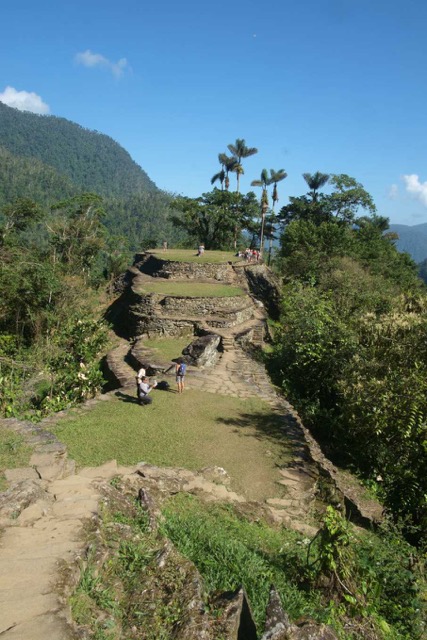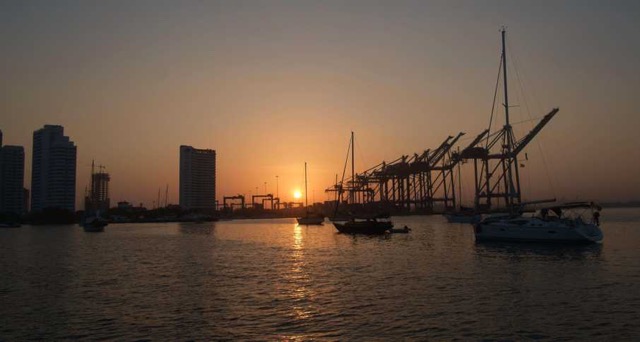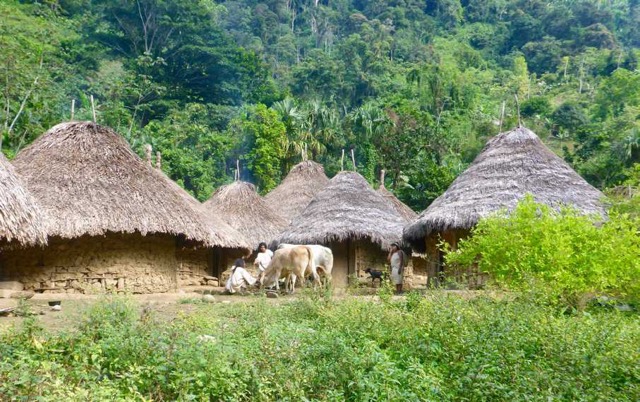Getting Ready for the Sea Again.

Vega
Hugh and Annie
Sun 5 Feb 2017 01:25
10:24.5N 75:32.6W The most obvious cultural tradition is that the men, from the age of 18, all chew coca leaves (picked by their wives of course) and seem to be on a permanent high. This gives them great stamina (they can go for days without eating or sleeping) and keeps them in touch with their spiritual ancestors. All well and good but being continuously stoned you would think would make you a pain to live with and doesn’t do much for cultural development. They won’t chop down a tree without consulting the village Shaman because they consider themselves part of the living community of plants and animals. So, a lifestyle that appears to be far more sustainable and spiritually satisfying than our western market capitalism - but maybe it would drive all of us to chew coca leaves. In Europe the standard gas for a boat for cooking is butane that comes in blue 2.5kg steel cylinders marketed as Camping Gaz. On this side of the Atlantic it is propane, which is stored at slightly higher pressure. Everyone crossing the Atlantic faces the conundrum of whether you can safely store and use propane with butane cylinders and with or without adaptor regulators. Our Google research suggests that both are low pressure and well within the strength of the steel cylinders. Also, having actually read the manual, it would appear that our cooker can run on either of the gases and the burners can be adjusted for each. So, apart from the fact that propane burns less well when the burner is turned up high (as others have noticed also) we and many others simply run our butane systems with propane. In fact there is a move towards a 50/50 mix of the two gases as a standard. The issue came to a head for us in Santa Marta when we needed to use the last of our four gas cylinders but it wouldn’t release the gas when the regulator was screwed on. All four were sent off for checking and refilling and it transpired that three of the four were leaking (the steel corrodes badly in a marine environment) and only one was both not leaking and would release its gas through the regulator. So, we bought a 5kg steel cylinder to tide us over, kept the functioning small one as a backup and have two more aluminium (rust proof) equivalents ordered for collection in Panama. The 5kg cylinders have different (US) attachments for the regulator and the new regulator needs to be fixed away from the cylinder to allow them to fit in the locker so a bit of work to do in Panama. Before transiting the Panama Canal there is a certain amount of formality, payment and so on to be undertaken. You can do this yourself or engage an agent which reduces the hassle and simplifies arrangements. We, along with many others, have opted for an agent, in our case Erick Galveth. Through Erick we have our SIN (Ship Identification Number) for the transit and he will arrange for the boat to be measured, hire of lines and fenders, pilot to come aboard for the transit, date for the transit and take care of the payment without a trip to a bank to make a transfer and set up a refundable deposit. This means we will be able to concentrate upon provisions, equipment and maintenance before heading out into the Pacific. Once in the Pacific our first port of call will be the Galapagos. This must be the most expensive and bureaucratic place to take a yacht. The hull must be cleaned, the interior fumigated and fees paid for everything conceivable to the authorities. Only the determined will visit and we know of other boats that will sail past. However, we would regret forever not visiting while so close and so we have another agent, Johnny Romero, on board………… We washed down the boat, put the mainsail back on and got everything shipshape for our departure from Santa Marta. We even bought a new mooring line to better secure our finger pontoon before we left only to have it disappear the day before. All a bit of a mystery but at least the marina replaced it for us. We were planning to leave with Nautilus, an Ovni 395 with Ian and Steph on board, but decided to delay a day for final provisioning and haircuts. They had wind of 35kts for their overnight sail down to Cartagena so we sat out the following night on the fuel pontoon at the marina when we saw the forecast for even stronger wind. On Thursday morning we did get away and the wind was stronger than forecast at up to 30kts. Passing the river Magdalena four miles offshore the water abruptly turned brown along an amazingly abrupt line. We had read about tree trunks and other flotsam to look out for and were so intent on this that we didn’t notice a large breaking wave coming up from behind and that we heard just before it caught us and rolled Vega onto her side, washing the lifebelt off the cockpit rail. I briefly saw its bright fluorescent orange trailing behind on the attaching line to the boat before it parted from the line, never to be seen again. A good job we never had to rely upon it to recover a person overboard! With the strong wind we were making faster progress than planned and so opted for an overnight anchor with an early start on Friday morning. It was just getting dark as we put our anchor down in Puerto Valero, described as one of the best anchorages on the Colombian coast. By chance we were next to Paul, Jane and Lily in Delphinus who had taken the same option. At 0400 we were raising the anchor when the electric windlass stopped working. Fortunately we have a manual option also and after what seemed an eternity cranking the chain up one or two links at a time I found the anchor had twisted through 180 degrees on the chain and would not stow. This has happened before and we must figure out how to prevent it as twisting the anchor back has to be undertaken with a loop of rope around the anchor whilst making the final hoist. Our intended destination was the Rosarios Islands off Cartagena en route to San Blas. However, our windlass needed sorting and so we opted to go into a marina in Cartagena where there would be repair facilities if required. It turned out that the marina was full and boats had to anchor off! So out came the service manual for the windlass and the electrical diagram for the boat and I tracked down the 125Amp fuse for the windlass in the rear cabin. We had a spare on board and were able to replace the blown fuse in a trice and set the anchor! Had we checked the fuse earlier we might not have come into Cartagena and would have missed the amazing modern city that we are now within. It is all elegant white high rise housing, offices and hotels and a busy commercial container port that we are close to. A bigger contrast with the indigenous people’s houses in Tayrona you could not conceive. I know which is the more sustainable way of living but also which is the more exciting…………….. Tonight we head over towards San Blas where on Tuesday we are being joined by Jon and Jackie from Bristol (Ambling Band friends) for week in the San Blas before sailing with us on to Panama. .      |